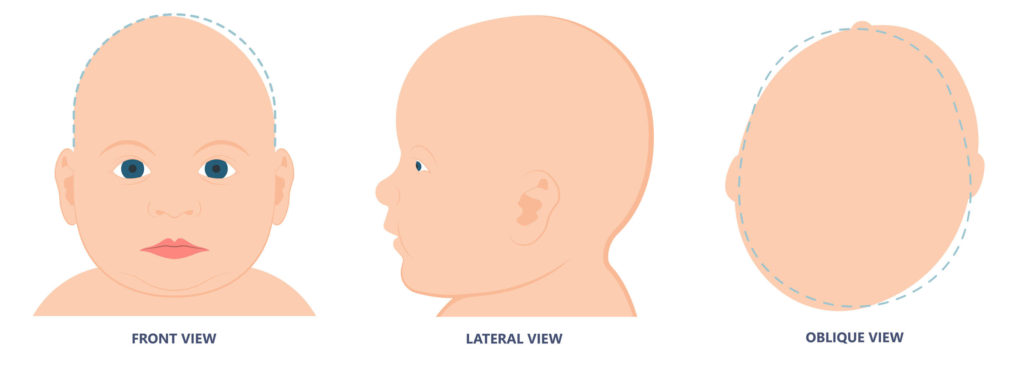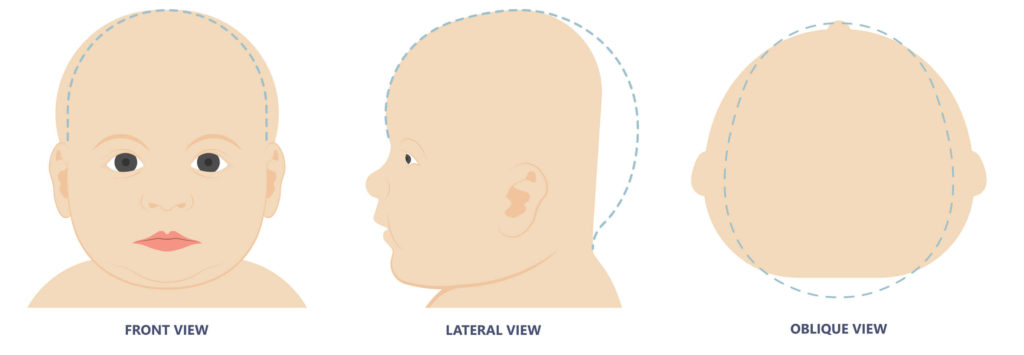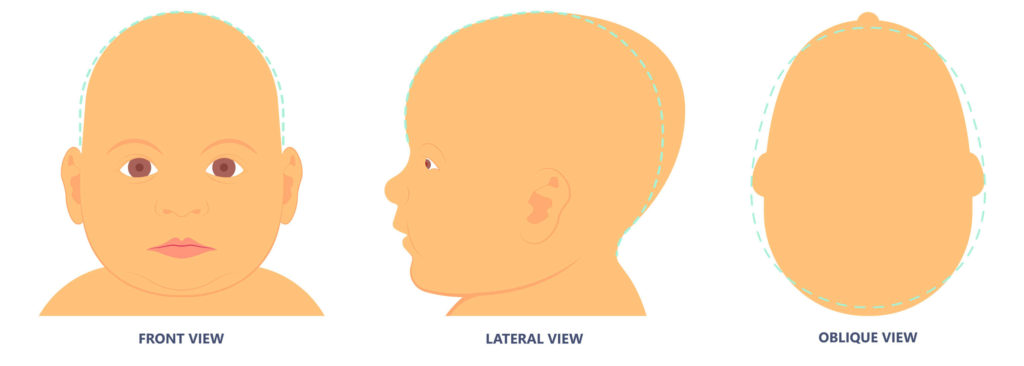Atypical Head Shapes in Infants
The three main types of irregular or atypical head shapes in infants are Plagiocephaly, Brachycephaly and Scaphocephaly, which various factors can cause. Positional factors cause Plagiocephaly and Brachycephaly and these two conditions can often appear in combination with each other. Non-positional factors and positional factors (such as a long time in the neonatal ward) can cause Scaphocephaly.
Plagiocephaly: Plagiocephaly refers to a condition where the baby’s head becomes flattened on one side, resulting in an asymmetrical shape. The flattening usually occurs on the back or side of the head, causing a noticeable flat spot. Plagiocephaly can be caused by factors such as prolonged pressure on one area of the skull, consistently lying in the same position, or favouring one side of the head while sleeping, also known as Torticollis (asymmetrical neck position). Torticollis is a condition that is characterized by the tightening of one side of the neck, causing the child’s head to turn in one direction and tilt in the opposite direction. This condition can lead to the flattening of one side of the skull and potential difficulties in motor skill development.
Brachycephaly: Brachycephaly involves a flattening of the back of the head, causing it to appear wider than usual. The head shape may appear rounder and broader from the back, giving it a flattened appearance. Brachycephaly can occur due to prolonged periods of time spent lying on the back, such as during sleep or when placed in car seats or other devices that restrict movement.
Scaphocephaly: Scaphocephaly is characterized by a long and narrow head shape. The condition is caused by premature fusion of the sagittal suture, which is the primary suture that runs along the top of the skull. This premature fusion restricts the skull’s growth in the transverse direction, leading to an elongated and narrow appearance. Scaphocephaly is also common in babies who have spent extensive time in the neonatal ward as babies are turned side to side.
Positional Factors
Positional plagiocephaly or plagiocephaly, is a condition that affects infants and is characterized by the flattening of one side or the back of the head and is the most common cause of irregular head shapes in infants. It occurs when an infant’s head develops a flat spot due to prolonged pressure on a particular area. The main cause of plagiocephaly is prolonged pressure on a specific part of the baby’s skull. This pressure can be a result of spending too much time lying on the back or in one position, such as when sleeping or resting in car seats, swings, or strollers. Maternal factors during pregnancy such as limited intrauterine space, uterine abnormalities or multiple births can also contribute to pressure areas. The soft bones of an infant’s skull are malleable and can be easily molded by external forces.
There are two common types of atypical head shapes, Plagiocephaly and Brachycephaly, neither typically cause any cognitive or developmental delays. However, if left untreated, it may lead to cosmetic concerns or, in rare cases, affect the alignment of the skull and facial features.
It’s worth noting that plagiocephaly and brachycephaly can coexist in some cases, and a baby may exhibit a combination of symptoms. The severity of these conditions can also vary, ranging from mild to more pronounced cases. This is known as asymmetrical Brachycephaly.
Plagiocephaly
The characteristics of plagiocephaly may include a flattened area on one side of the head or at the back of the head, an asymmetrical head shape, or a forehead that appears more prominent on one side. In severe cases, the ears and facial features may also appear uneven or misaligned. Plagiocephaly does not typically affect brain development or cause any neurological problems, but early intervention is important to prevent the condition from worsening.

Symptoms Commonly Associated with Plagiocephaly
- Asymmetrical head shape
- Flattening of one side of the head or a diagonal flattening pattern
- Uneven ear positioning (one ear may appear more forward or lower than the other)
- Facial asymmetry (features on one side of the face may be more prominent or misaligned)
- Uneven hair distribution or hairline
- Possible forehead prominence on the flattened side
- Developmental milestones are typically normal
Brachycephaly
Brachycephaly is characterized by a flattened area at the back of the skull. Parents typically observe their infant’s brachycephalic head shape around the age of eight weeks, noticing a broader head than expected with ears that stick outwards. A slight bulge on the forehead may also be present.

Symptoms Commonly Associated with Brachycephaly
- Wide and shortened head shape
- Increased width of the head compared to the length
- Flattening at the back of the head (occiput)
- Rounded appearance of the skull
- Bulging or prominent forehead
- Midface may appear slightly flattened
- Developmental milestones are typically normal
- Facial asymmetry is usually minimal or absent
Non-positional Factors
Non-positional factors can also contribute to head asymmetry in infants. These factors are unrelated to external pressures and positioning and may be caused by various underlying conditions or developmental factors. Craniosynostosis, birth trauma, intrauterine factors, genetic conditions and torticollis are all examples of non-positional factors.
Scaphocephaly
Scaphocephaly is a type of craniosynostosis, a rare congenital condition in which the bones of an infant’s skull fuse too early, leading to an abnormally shaped head. In scaphocephaly, the head appears long and narrow, with a prominent forehead and a pointed back. The term scaphocephaly comes from the Greek word “skaphē” which means “boat,” referring to the boat-like shape of the skull. The condition occurs when the sagittal suture, which runs along the top of the skull from front to back, fuses prematurely. This prevents the skull from growing normally in width and results in the characteristic elongated and narrow shape. Positional factors may also contribute to Scaphocephaly such as a long time in the NICU where a baby’s head is turned from side to side.

Symptoms Commonly Associated with Scaphocephaly
- Elongated or boat-shaped head
- Narrow head width compared to the length
- Prominent and bulging forehead
- Ridge or keel-like appearance along the midline of the skull
- Flattened sides of the head
- Increased distance between the eyes (hypertelorism)
- May have a high, narrow palate
- May have a prominent occiput (back of the head)
- Usually, no facial asymmetry is present
- Developmental milestones are typically normal
Torticollis
Torticollis, characterized by tightness in one side of the neck, causes the child to exhibit a head turned in one direction and tipped in the opposite direction. This condition can result in flattening on one side of the skull and potential motor skill development difficulties.
There are two main types of torticollis:
Congenital muscular torticollis is the most common type and typically manifests shortly after birth or within the first few months of life. It occurs when one of the neck muscles, the sternocleidomastoid muscle, becomes tight or shortened, causing the head to tilt and rotate. The exact cause of congenital muscular torticollis is often unknown, but it may be related to the baby’s positioning in the womb or birth trauma. The estimated incidence of congenital muscular torticollis is <1% of all live births.[1]
Acquired torticollis: This type of torticollis can develop later in infancy or childhood and is usually associated with an underlying condition or injury. Acquired torticollis may be caused by inflammation or infection of the neck muscles, trauma, spinal abnormalities, or other medical conditions.
If torticollis is not detected early, it can lead to additional complications, including positional plagiocephaly. This condition occurs when the infant’s preference for head turning causes them to consistently rest on one side of their head, resulting in flattening on that side of the skull.
(1) – Pediatric Orthopaedic Society Of North America (POSNA)
Symptoms of Torticollis
- Head tilt: The baby’s head is consistently tilted to one side, with the ear on that side closer to the shoulder.
- Limited range of motion: The baby may have difficulty turning their head to the opposite side or may show resistance or discomfort when attempting to move the head to a neutral position.
- Facial asymmetry: Prolonged torticollis can result in facial asymmetry, with flattening or bulging of the affected side of the face.
- Preference for one side: The baby may consistently turn their head to one side during waking and sleeping.

Prevention & Treatment
While some cases of Plagiocephaly cannot be prevented, there are some steps parents can take to reduce the likelihood of their child developing an asymmetrical head shape:
- Repositioning: Varying the position of the infant’s head during sleep can help prevent flat spots from forming on the skull. The American Academy of Pediatrics and Health Canada recommend placing infants on their backs to sleep, but alternating the position of the head can help distribute pressure evenly.
- Tummy time: Encouraging supervised tummy time while the baby is awake and alert can help prevent a flattened head shape. This helps to strengthen the neck muscles and reduce pressure on the back of the head.
- Holding and carrying: Frequent holding and carrying of the infant, as well as avoiding long periods in car seats, bouncy seats, or swings, can help relieve pressure on the head.
- Orthotic helmets: In cases where repositioning and tummy time have not been effective in correcting brachycephaly, an orthotic helmet may be recommended. These helmets are custom-made to fit the infant’s head and apply gentle pressure to encourage symmetrical skull growth.
Ortho Design is a certified service provider for STARband pediatric head shape devices, the most prescribed Cranial Remolding Orthosis (CRO) in the world. These infant head helmets produce excellent results and have no known head growth side effects.
More About Infant Cranial Remolding Orthoses |
Head Remolding Helmets
Infant cranial orthotics is a common
treatment for asymmetrical
head shapes in infants. Learn more ...
Why StarBand?
STARband is the most prescribed Cranial Remolding Orthosis (CRO) in the world with over 600,000 infants worldwide benefiting from the STARband since 2000. Learn more ...
Misconceptions About Foam
Cranial Remolding Orthoses?
Misconceptions or trendy advertising about foam Cranial Remolding Helmets and often cloud people's understanding of their purpose and effectiveness ... Learn more
